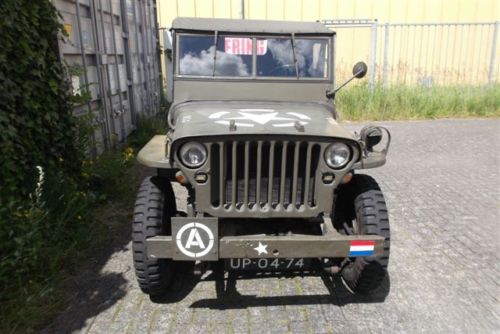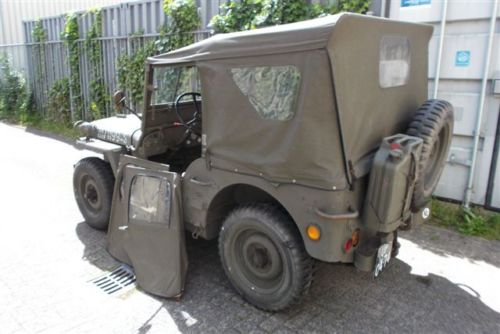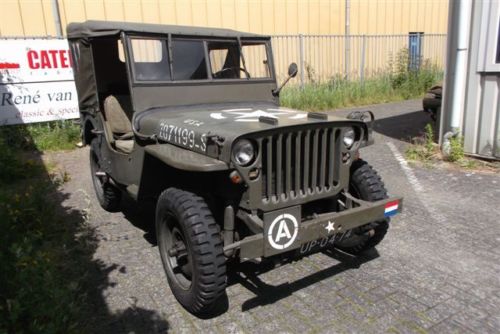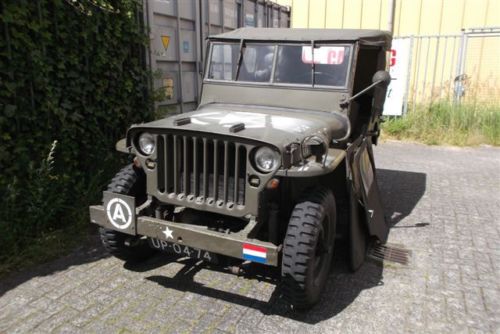World War II saw the creation of one of America’s most beloved vehicles, the Jeep. Now primarily produced for consumer use, the Jeep was once a military workhorse designed to move troops, help the wounded and more.
The story of the Jeep begins in the late 1930s, when the United States military was searching for a vehicle that was light, rugged and could travel over rough terrain. By the early 1940s, the Jeep’s design was complete, and the rest is history. Before we get to the details of this Jeep which is for sale, lets have a look at some facts:

1.
Originally 1,300 pounds, the vehicles proved to be too light. The weight was later revised to 2,160 pounds. Today, a Jeep Wrangler can weight anywhere from 3,900 to 4,900 pounds
2.
The Jeeps had a minimum ground clearance of 6.25 inches and a wheelbase of 80 inches. This meant that the vehicle from bumper to bumper was over 10 feet long.
3.
Payload wasn’t really an issue, but it could haul between six hundred to a thousand pounds if necessary.
4.
Jeeps came with a spare wheel, usually located on the back, as well as a gas tank which could be attached to the side.
5.
Ford designed the now famous stamped grill during World War II. This is the same grill design that you see on Jeep Wranglers today. The original grill was composed of 9 slots. Willy’s-Overland Motor would later change their Jeeps to a 7 slot grill, which is what the Jeep brand has stuck with since. The move was made because Ford Motor Company had copyrighted the 9 slot grill.
6.
Jeeps served in all theaters for the United States and were also used in lend-lease programs by allied countries

7.
Jeeps were used to carry the wounded, as there was a back seat which could be converted to a stretcher. Other uses included laying communication lines and transporting high-ranking officials around.
8.
While the Jeeps primary use was for the ground, it could be converted to rail use if necessary. Once converted to a train, Jeeps had the ability to pull up to ten tons by rail.
9.
Ford was commissioned to build an amphibious Jeep, to be named “Ford GPA.” Once built, the vehicle proved to be unsuccessful as it was slow, heavy and performed poorly in the water. There were nearly 13,000 of these produced. Many of these went on to be used by the Soviet Union, who used them for crossing rivers. They would later create their own design of this amphibious vehicle.
10.
The exact reason Jeep got the name Jeep is unknown. However, it is believed that it could be from Ford’s use of the abbreviation GP on the Ford GP and Ford GPW, with the “G” meaning “Government” and the “P” designating the vehicle as having a wheelbase of 80 inches. Other popular theories include an idea that it is based on the cartoon character, “Eugene the Jeep.” Wherever the name came from, it saw widespread use during World War II, to describe the legendary line of vehicles.
Below are the details of this beauty!
This is my pride and joy Willy’s Jeep. I have spent a lot of money refurbishing it as per the DVLA. Owners of old classic cars over a certain lineage are expected to maintain them more than modern vehicles. Because I fall into this category I have not scrimped or scraped when renewing anything.
My theory is/was if I spend the money then the car will not let me down when going to military fairs here and abroad. I have replaced the petrol tank, the water pump, the generator and voltage regulator. Replaced the spark plugs and oil filter. renewed the fuel/water filter. New brakes and hoses front and back.

Water radiator refurbished by local specialist. New water hoses. New sump gasket. Grease nipples all round renewed or replaced as needs. Grease applied. Ignition points replaced with electronic ignition and a new coil too.
For more details and place a bid check out eBay
All parts renewed will be included as spares. This vehicle is as original as I could keep it. I will consider adventurous offers.
